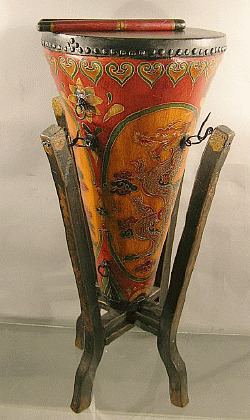 | ||
The bangu (Chinese: 板鼓; pinyin: bǎngǔ), often simply gu (Chinese: 鼓; pinyin: gǔ), is a Chinese frame drum that, when struck by one or two small bamboo sticks, creates a sharp dry sound essential to the aesthetics of Chinese opera. Striking the drum in different places produces different sounds. It is also used in many Chinese chamber music ensembles. The percussion section is very important in Chinese Opera, with battle or 'martial' scenes, which are called wu-chang. The bangu player is the director or conductor of the orchestra. He works with the other members of the percussion section to create the right mood for the audience and actors on stage.
Construction
The drum, which is about 25 cm (10 inches) in diameter and 10 cm (4 inches) deep. The frame of the Bangu drum is made of wedges of hard wood glued together to form a circle. Animal skin is then stretched over the frame of wedges, which is then secured by a metal band. The wedges do not reach the small area in the centre (the drum’s heart or "guxin") where the drum is struck. The bangu is held in its own stand with four iron rings.
Some versions have only three rings and three supporting legs. These versions are usually portable, with a collapsible stand section.
